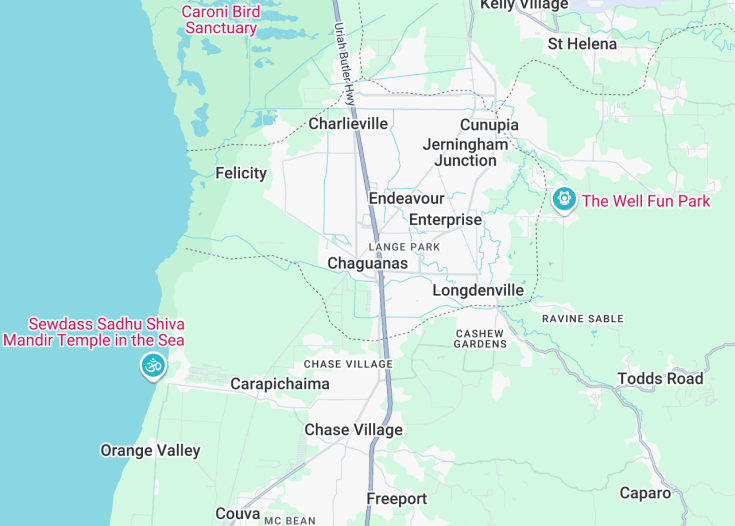Chaguanas, located in the heart of Trinidad, stands as a vibrant hub of culture, commerce, and lively festivities. It is renowned for its bustling market life, hosting one of the largest marketplaces in the Caribbean where fresh produce, crafts, and local cuisine abound. Chaguanas offers a blend of Hindu and Muslim traditions, evident in its numerous cultural festivals such as Diwali and Eid. The town is also a center for shopping enthusiasts, featuring both modern shopping malls and traditional street vendors, providing a dynamic retail experience that reflects its multicultural heritage.
To fully appreciate local culture, visit during the Divali Nagar celebration—Chaguanas illuminates with thousands of lights, showcasing rich traditions and performances.
Travelers should explore the Central Market early in the morning to experience the vibrant hustle and bustle of traders and to get the freshest products.
Top things to do & see in Chaguanas
Select the following sights and activities to discover best tickets and tours available in Chaguanas.
Chaguna: The Vibrant Heart of Trinidad
| Country | Trinidad And Tobago |
| Time in Chaguanas | GMT-4 |
| Language spoken | English |
| Population | 83,516 (2021 Census) |
| Currency | Trinidad and Tobago Dollar (TTD) |
| Airports |
|
Chaguanas stands as the largest and one of the most dynamic towns of Trinidad and Tobago, with a history deeply rooted in sugar cane production. Today, it has evolved into a bustling economic and commercial hub. Recognized for its vibrant market scene and cultural festivals, Chaguanas merges traditions and modernity creating a unique charm that draws people from all around the island and beyond. History reflects in the town’s architecture, with numerous heritage sites like the Lion House, a proud emblem of Indian diaspora’s influence. Culturally diverse and energetically paced, Chaguanas serves as a beacon of Caribbean ethos and industrious spirit, continuing to grow as it welcomes new businesses and tourists seeking both relaxation and adventure in its streets and markets.
Where is Chaguanas?
Located in the central region of Trinidad, Chaguanas is north of Couva and east of Port of Spain.
Distances:
| Route | Distance by car | Time by car |
|---|---|---|
| Port of Spain to Chaguanas | 18 miles | 30 minutes |
| San Fernando to Chaguanas | 14 miles | 25 minutes |
| Arima to Chaguanas | 14 miles | 20 minutes |
What is Chaguanas famous for?
Chaguanas is renowned for its spirited festivals including Divali, the Hindu festival of lights, and its bustling market that offers an array of exotic fruits, vegetables, and crafts unique to Trinidad and Tobago.
History
Pre-Colonial Period – Before 1498
Before the arrival of European colonizers, the region known today as Chaguanas was inhabited by the indigenous Carib and Arawak people. These communities engaged in agriculture, fishing, and trading with other Caribbean tribes. The lush environment provided them with abundant resources, allowing for a self-sustaining lifestyle.
Colonial Era – 1498-1838
Chaguanas, like much of Trinidad, came under Spanish rule following Christopher Columbus’s arrival in 1498. The area remained sparsely populated due to the difficulty of the terrain and the resistance from the native population. However, the discovery of sugar potential transformed Chaguanas during the British period, starting in 1797, with large-scale sugar plantations emerging, operated predominantly by enslaved Africans.
Post-Emancipation Period – 1838-1962
Following the abolition of slavery in 1838, Chaguanas saw a significant transformation. Former slaves started their communities, and the introduction of indentured laborers from India influenced the cultural landscape profoundly. Over time, these communities cultivated the land extensively, paving the way for Chaguanas to become a vital agricultural hub in Trinidad.
Modern Era – 1962-Present
Since Trinidad and Tobago’s independence in 1962, Chaguanas has transformed into one of the fastest-growing commercial centers in the country. It has diversified economically, venturing beyond agriculture into manufacturing and services. This era also marks significant urban development, with the expansion of infrastructure and residential areas accommodating the growing population and business needs.
Visit Chaguanas
What to see and do in Chaguanas
Chaguanas offers a mix of cultural and natural attractions that warrant exploration. Visitors can enjoy:
- The Chaguanas Market, known for its vibrant atmosphere and variety of local fruits, vegetables, and crafts.
- The Dattatreya Temple and Hanuman Statue, showcasing impressive architectural work and spiritual significance.
- The Waterloo Temple, set majestically at the edge of the sea and providing stunning views and tranquility.
- Central Park Chaguanas, perfect for leisure walks and enjoying the tropical climate.
Festive Chaguanas
Chaguanas is buzzing with cultural festivities throughout the year. Notable events include the colorful Diwali celebrations, featuring magnificent light displays and cultural performances, usually in October or November. Another highlight is the Phagwa festival, celebrated in March, where locals and visitors alike partake in traditional music and color throwing, symbolizing the victory of good over evil.
Best time to visit Chaguanas
The ideal time to visit Chaguanas is during the dry season, from January to May. This period features less rainfall and a more comfortable climate for exploring the outdoors and participating in festivals. Additionally, visiting during this time allows tourists to experience the vibrant Phagwa and Easter celebrations.
Is Chaguanas worth visiting?
Chaguanas offers a unique blend of cultural richness and scenic beauty, making it a worthwhile destination for travelers seeking both relaxation and cultural immersion. However, visitors should be prepared for tropical weather, with possible humidity and rain during the wet season. Despite these minor inconveniences, the town’s friendly locals, diverse cuisine, and range of activities from shopping to sightseeing provide a compelling experience for all types of travelers. The burgeoning economy also means that amenities and accommodations are constantly improving, ensuring comfort during your stay.











